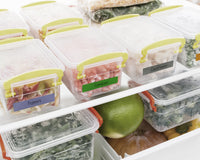There is a lot of fun and nostalgia in flipping through rows and rows of cards in a trading card shop, building your dream deck, and taking your newfound treasures to the checkout counter. However, this high-contact method of shopping is not ideal for a number of reasons, from damage to cards to lost inventory to the Sisyphean task of putting cards back in the right place. Following the top organization tips for trading card shops is especially useful for businesses going digital who need to keep an efficient process for finding the cards customers have ordered.
Physical Inventory
While any small business can benefit from general organizational tips, trading card shops are uniquely charming. They have an inherently whimsical atmosphere. Walking in to see rows and rows of cards is extremely fun for customers but keeping that experience from becoming an exhausting and overwhelming mess is as important as impressing guests. The best tip for organizing physical inventory in a trading card shop is to maintain great storage and an easy-to-follow system for putting cards away.
Card Boxes
Card boxes are one of the most inexpensive and essential tools for gaming shops trying to organize their trading cards. These card boxes are often white corrugated cardboard rectangles that extend enough to fit between 200 and 5,000 cards and are iconic to the game shop industry. Stackable plastic card boxes are available for shops concerned about mishandling, water, or normal wear and tear damage. A shop should always limit the number of cards allowed per box to prevent overcrowding that can warp and rough up cards frequently taken out and put back.
Card Binders
For higher value cards or completed sets sold as a whole, binders are a more effective method for organization. Trading card binder sleeves have plastic slots that fit either single or back-to-back cards that customers and employees can easily peruse. Plastic binders are another cost-effective organizational tool that looks and performs great in front of or behind the counter. Sadly, binders aren’t effective for storing all cards, as high-frequency cards will take up entire binders and a significant amount of shelf space.
Effective Labeling
Shops should make the process of returning cards to where they go clear for customers and employees. One of the best ways to ensure that cards end up in a trackable location until they’re needed again is effective and purposeful container labeling. Using high-visibility neon labels will draw the eye right to where you need viewers to look, increasing the chances that they will adhere to your organization system.
Labels for trading cards can include a variety of information, so compare different sizes for your labels. One layout for trading card box labeling might look like this:
- Name of the card game
- Series/set name
- Year the set was released
- Card number or alphabetical range
Color-Coding
Color-coding can quickly signal to both your customers and team how your shop’s organization system works. If your shop carries many trading card games, color-coded stickers are a way to instantly communicate which game is in which binder or box. Your shop can place a legend of the color code throughout the store, allowing customers to browse while employees can increase their productivity with faster inventory storage.
You can also use color-coding dots to indicate information on sealed or protected cards. Placing a color dot on the plastic binder sleeve or on the card sleeve itself can signal reserved cards, limited supply cards, or in-demand cards to employees, assisting them as they help customers.
Digital Inventory
Card trading shops often keep inventory numbers in the thousands, and each sale or delivery directly impacts what you can and can’t offer to buyers. Keeping a digital inventory of your product is virtually non-optional for trading card shops who want to provide accurate information to their customers and, in turn, increase customer satisfaction. One of the last things you want to do is show an incorrect number of available cards to a player looking to build their dream deck.
Spreadsheets
Using spreadsheets is one of the best and most malleable ways to keep track of your entire inventory. Excel and other spreadsheet software can handle the large stock numbers of trading card shops while retaining the necessary editability. We suggest that inventory books follow a consistent template or structure that allows shops to add new sets and games in a way that will allow employees to smoothly transition between products. Businesses can also match the color schemes of their spreadsheet cells to the labeling and color-coding in the store by using the customization tools in spreadsheets, making it easy for employees to use the inventory as a resource for card locating and organizing.
Inventory Software
Many inventory software alternatives are becoming available to business owners. A more approachable user interface or a focus on synchronized use across multiple devices makes certain programs more appealing than spreadsheets. Most inventory software brands also program with customer relationship management (CRM) in mind; for small businesses, multi-function software is an amazing tool.
Owners need to make sure that the software they choose can handle more than the number of unique products they currently have, as the trading card industry is routinely releasing new series, packs, and cards. How-to videos and tools are also great to have for new hires and consistent training.
Customer Handling
One place that trading card shops lose direct control over their inventory is in customer handling. Browsing is a major aspect of the gaming industry, so where and how customers remove and put back inventory is frustrating. A shop will need to decide how to organize their cards and how to organize the way customers interact with them.
Some shops may value the customer’s experience of filtering through cards and picking up a growing number along the way until they reach checkout. Others might prefer keeping the cards behind the counter and taking out specific boxes and binders on request, allowing customers to interact with the inventory at the counter where an employee can easily assist them and keep the cards organized.
Most players have a deep love and respect for card shops, so creating a system that helps you effectively serve them and helps them keep your inventory organized is a worthwhile goal. Using these top organization tips for trading card shops will create a more efficient shopping experience, making players more likely to return to your business. At ChromaLabel, we offer various organizing solutions to fit the pre-made and custom labeling needs of businesses. We are happy to help you get your card inventory system on track with color-coding dot stickers and custom adhesive labels that perfectly suit your needs. Call us if you need additional help at (800) 256-0435.







